Hofamterspiel, c.1460
Hofamterspiel, c.1460

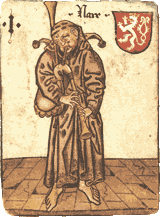 |
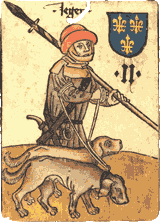 |
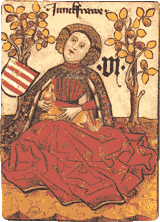 |
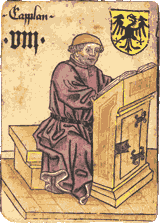 |
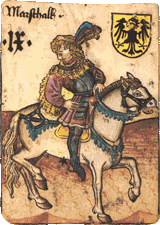 |
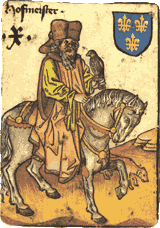 |
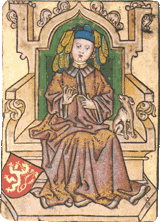 |
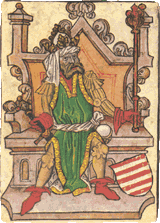 |
|
The cards were printed from woodblocks and then hand coloured. Each suit in turn shows members of the royal household - from the court jester up to the king's steward, including servants and court officials. These are depicted in a hierarchy, numbered 1 - 10 in Roman numerals, plus a queen and king, instead of the more common arrangement of multiple pip cards and three or four court cards. There are 48 cards in total. |
Click images to see enlargements. See also: The Stuttgart Cards, 1437 Cards shown above are from the facsimile edition published by Piatnik, Vienna, edited by Ernst Rudolf Ragg, 1976. Size of cards 140 x 100 mms. |
||
The Hofämterspiel reflects political relationships in Central Europe in the mid-15th century. The suit signs are the coats of arms of four kingdoms: France, Germany, Bohemia and Hungary. The single-headed eagle represents the 'regnum teutonicum', the kingdom of Germany (as opposed to a double-headed eagle representing the Holy Roman Empire of the German Nation). Each individual card depicts a function or profession that enjoyed official status at a late medieval princely court.
In some respects the Hofämterspiel reminds us of the so-called Mantegna Tarocchi, a set of 50 copper engraved cards from Italy, c.1465, which also represents a world order, or hierarchy. However, the Italian set reveals cosmological overtones more akin to Renaissance humanism than to medieval European feudalism. The Hofämterspiel shows a feudal social hierarchy and is a good indication of what the oldest German playing cards may have been like, before they adopted symbols from the royal hunt…


By Simon Wintle
Member since February 01, 1996
I am the founder of The World of Playing Cards (est. 1996), a website dedicated to the history, artistry and cultural significance of playing cards and tarot. Over the years I have researched various areas of the subject, acquired and traded collections and contributed as a committee member of the IPCS and graphics editor of The Playing-Card journal. Having lived in Chile, England, Wales, and now Spain, these experiences have shaped my work and passion for playing cards. Amongst my achievements is producing a limited-edition replica of a 17th-century English pack using woodblocks and stencils—a labour of love. Today, the World of Playing Cards is a global collaborative project, with my son Adam serving as the technical driving force behind its development. His innovative efforts have helped shape the site into the thriving hub it is today. You are warmly invited to become a contributor and share your enthusiasm.
Related Articles

Luditz Pattern by Georg Geiselreiter
The discovery of 2024 changes the current state of knowledge of the history of this pattern.

French Revolutionary cards by Pinaut
Seven cards from a French Revolutionary pack by Pinaut featuring characters from classical antiquity...

Tarot de las Coscojas
Historical playing card design, tarot symbolism and an almost psychedelic medieval surrealism.

Ukraine playing cards
Historical figures from Ukraine’s past in a familiar Piatnik style.

MITSCHKAtzen
Clever cat designs by the Austrian artist and illustrator Willi Mitschka.

Tarock Cards by NIL Spielkartenfabrik
A deck of tarock cards from the eastern end of the ending Austro-Hungarian Empire.

Whist by Ditha Moser
Ditha Moser created this minimalist Whist deck in 1905, in the style of the Vienna Secession art mov...

Gabriel Uffenheimer
Rare example of the production of Johann Gabriel Uffenheimer, Guntramsdorf, 1825.

Play Architecture
Twentieth century architects and their creations on a well-designed pack from Finland.

Art pack I
Art pack featuring Old Masters, including Bruegel, Vermeer, Titian, Raphael, Caravaggio, Canaletto, ...

Les Jeux de Pastor
Striking designs by Edouard Pastor focusing on the heads of figures from the medieval period.

Karl Korab
Austrian artist Karl Korab’s first pack, displaying his use of different techniques.

Le Jeu des Personnages de l’Antiquité et du Moyen-Age
Edouard Pastor’s designs in black and gold inspired by Antiquity and the Middle Ages.

Rouen Pattern - Portrait Rouennais
An attractive XV century French-suited design from Rouen became the standard English & Anglo-America...

Johann Nejedly Tarok Cards
Johann Nejedly, a 19th-century Viennese card maker, produced Tarock cards featuring modern scenes th...

Austria Ski Team playing cards
Photos of members of the Austrian skiing team replace the normal courts on two different packs.
Most Popular
Our top articles from the past 28 days

